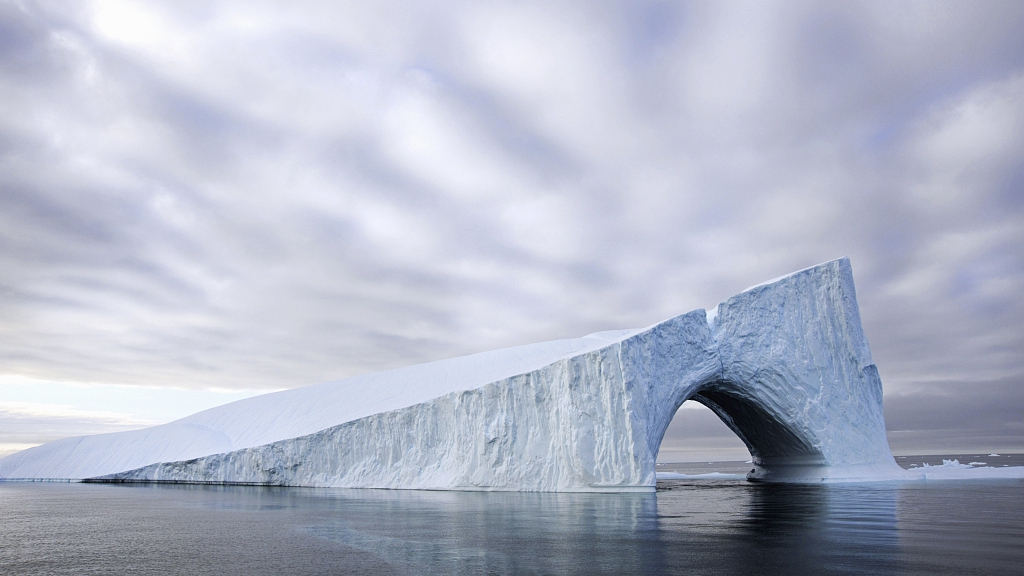The 5th International Arctic Forum in St. Petersburg from April 9 to 10 has once again brought global attention to this vast icy sphere.
As stated on its official website, the forum tends to bring together different entities – government bodies, international organizations and the scientific and business communities of Russia and other countries – for an exchange of views on issues impacting sustainable growth in the Arctic region.
This forum reflects how popular the polar area has become. Indeed, in recent years, due to the irreversible trend of global warming, the ice melting in the Arctic region has been expediting, opening up possibilities that once seemed implausible.
Why the Arctic is 'hot'
One remarkable event is the successful sailing of merchant ships through the Arctic's Northern Sea Route (NSR) without icebreaker escort, starting in 2017.
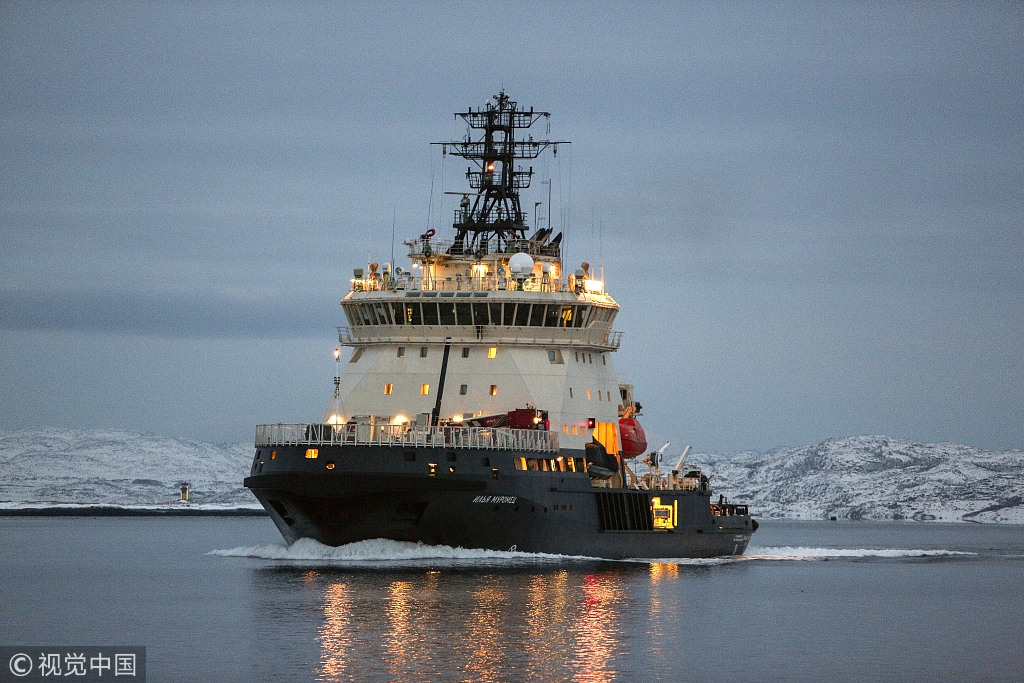
Russia's Ilya Muromets diesel electric icebreaker, which traveled from the Baltic Sea to Kola Bay, is seen arriving at the Northern Fleet base in Severomorsk, Russia, January 2, 2018. /VCG Photo
Russia's Ilya Muromets diesel electric icebreaker, which traveled from the Baltic Sea to Kola Bay, is seen arriving at the Northern Fleet base in Severomorsk, Russia, January 2, 2018. /VCG Photo
According to Global Risk Insights, an online publication for political risk news and analysis, previously, when forced to sail via the Suez Canal, shipments from Europe to Asia ranged up to 21,000 kilometers, but the Arctic passageway could shorten the distance by over 8,000 kilometers and cut transit time by up to 10-15 days.
Although the size of the cargo allowed to be carried along this route is much smaller, and the traversable period in the Arctic area is still brief – about three months a year – the speed has impressed many.
Another attraction of the Arctic is its resource reserves. The U.S. Geological Survey (USGS) revealed that the Arctic holds over one-fifth of the world's undiscovered energy resources.
What's more, Arctic resources include 13 percent of the world's undiscovered oil and 30 percent of its undiscovered gas.
The potential for shorter shipping time and resource extraction are a sure driver of more investment in this area.
Eager Arctic states
Eight countries, namely the United States, Russia, Canada, Norway, Sweden, Finland, Denmark and Iceland, are entitled to the Arctic territory.
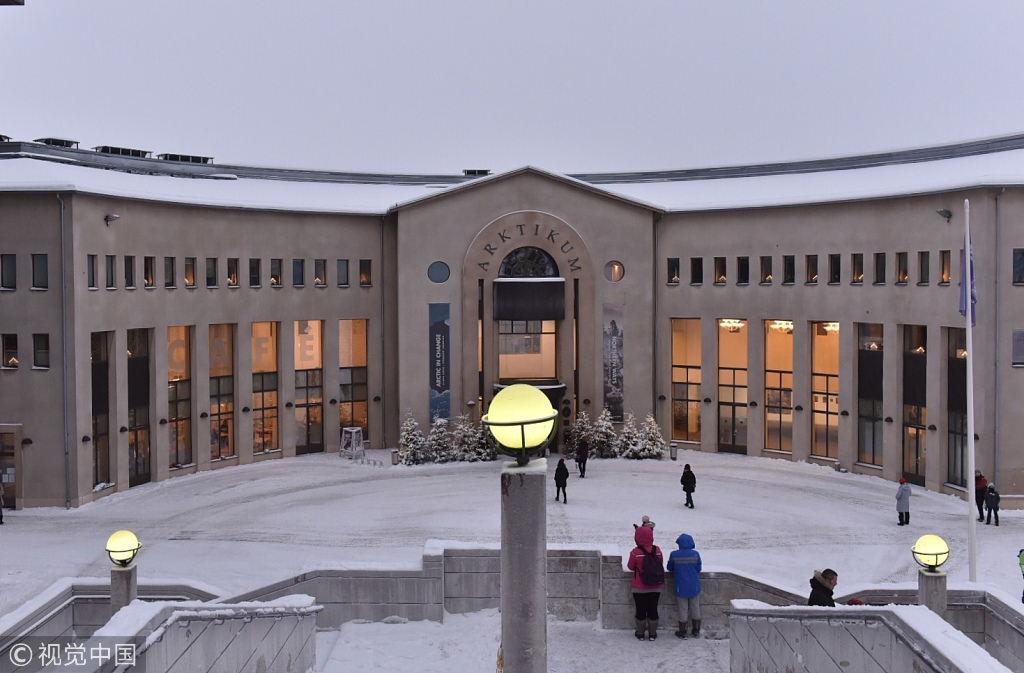
The Arktikum is a museum and science center in Rovaniemi, Finland. It is located inside the Arctic Circle. /VCG Photo
The Arktikum is a museum and science center in Rovaniemi, Finland. It is located inside the Arctic Circle. /VCG Photo
Despite the forming of the Arctic Council by these nations, each generally works out its own plan of developing the area since the council has no regulatory power.
In line with its history of exploration and production in the Far North, Russia has been steadily stepping up its presence in the Arctic.
An article as early as in 2014 by Foreign Policy Journal pointed out that Russian President Vladimir Putin had called for full government funding for "socio-economic development" in the region from 2017-2020, including a system of Russian naval bases to host ships and submarines for the defense of national interests involving the protection of Russian oil and gas facilities in the Arctic.
In recent years, Russia has also been partnering with neighboring countries, such as China, to explore energy resources in the area.
The Yamal liquefied natural gas project, which was launched in December 2017 and reached its full capacity one year later, has been a successful example.
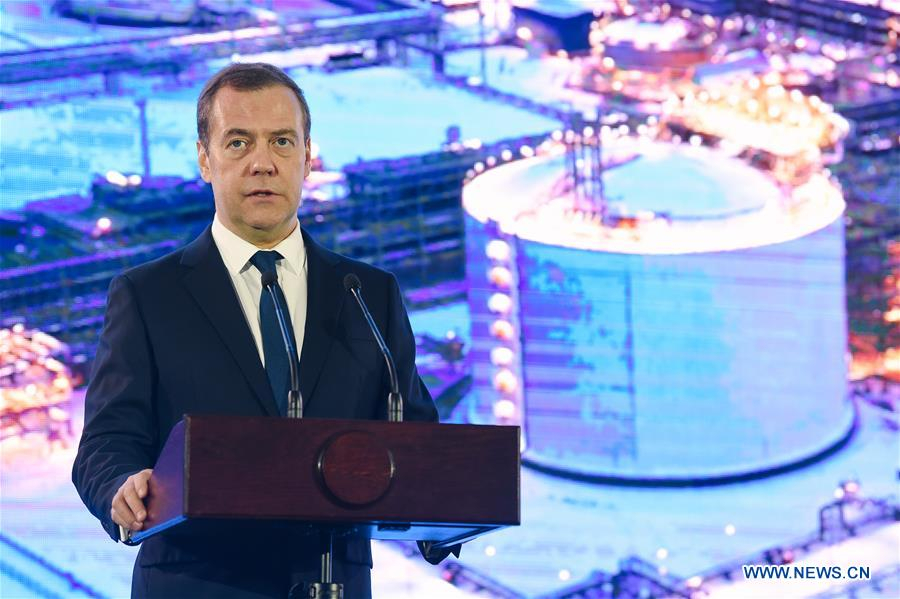
Russian Prime Minister Dmitry Medvedev speaks at a launching ceremony of the third production line of the Yamal liquefied natural gas project in Sabetta, Russia, December 11, 2018. /Xinhua Photo
Russian Prime Minister Dmitry Medvedev speaks at a launching ceremony of the third production line of the Yamal liquefied natural gas project in Sabetta, Russia, December 11, 2018. /Xinhua Photo
On Tuesday, at the ongoing International Arctic Forum, Putin disclosed that his country will shortly approve a new strategy for development of Arctic Russia by 2035.
"It should consolidate activities of our National Projects and state programs, investment plans of infrastructural companies and development programs of Arctic regions and cities," Russian news agency Tass quoted him as saying.
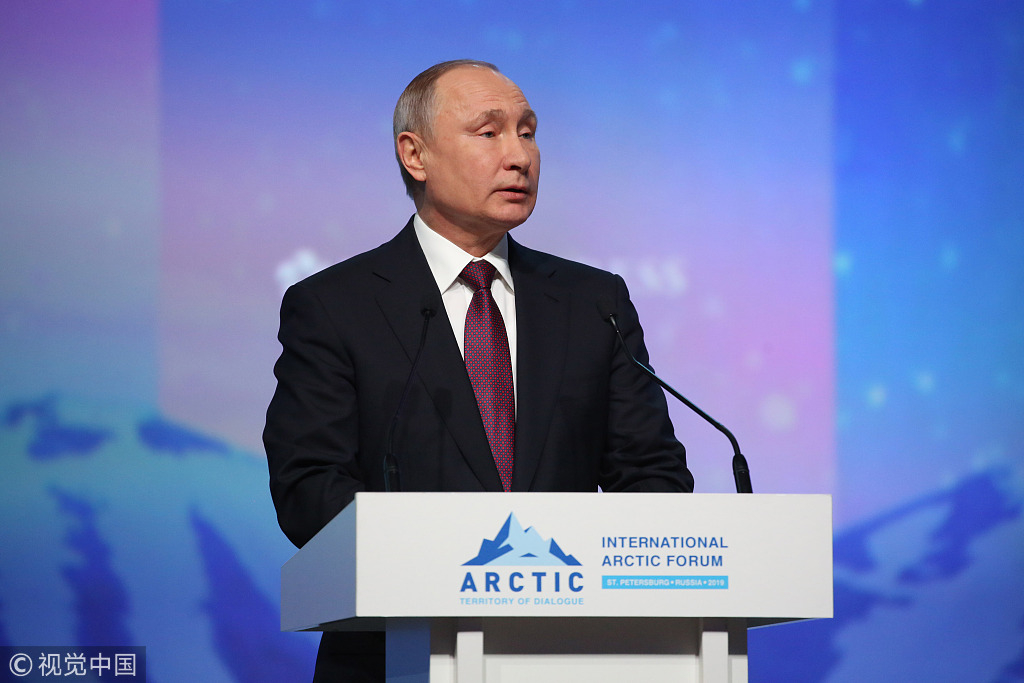
Russian President Vladimir Putin speaks at the International Arctic Forum in St. Petersburg, Russia, April 9, 2019. /VCG Photo
Russian President Vladimir Putin speaks at the International Arctic Forum in St. Petersburg, Russia, April 9, 2019. /VCG Photo
As to the U.S., the superpower is arguably lagging behind, particularly because of its limited international legal jurisdiction over exploration in the Arctic. Since it is not party to the United Nations Convention on the Law of the Seas (UNCLOS), it has no rights to the Exclusive Economic Zone's (EEZ) 200 nautical miles off its coasts.
However, the U.S. has striven to keep up. In 2017, the country's Department of Defense (DoD) released an updated Arctic Strategy.
In order not to lose out on the opportunities involving the Arctic passages, the strategy claims the passages to be international waters, thus fit for the conducting of the freedom of navigation.
The strategy also states that the DoD will boost existing limited polar communications capabilities, particularly satellite coverage. It will also seek to improve its threat detection and tracking capabilities in coordination with the Department of Homeland Security and partner nations.
Other stakeholders, such as Norway, have also taken actions in extracting minerals in the Arctic. In February this year, the Norwegian government approved a plan to begin mining for copper in the area.
China's BRI extends to the Arctic
As a state near the Arctic, China is also gearing up its efforts to extend its Belt and Road Initiative to the region.
Last year, China published
a white paper on its Arctic policy on January 26, pledging cooperative governance and elaborating on its vision for a "Polar Silk Road."
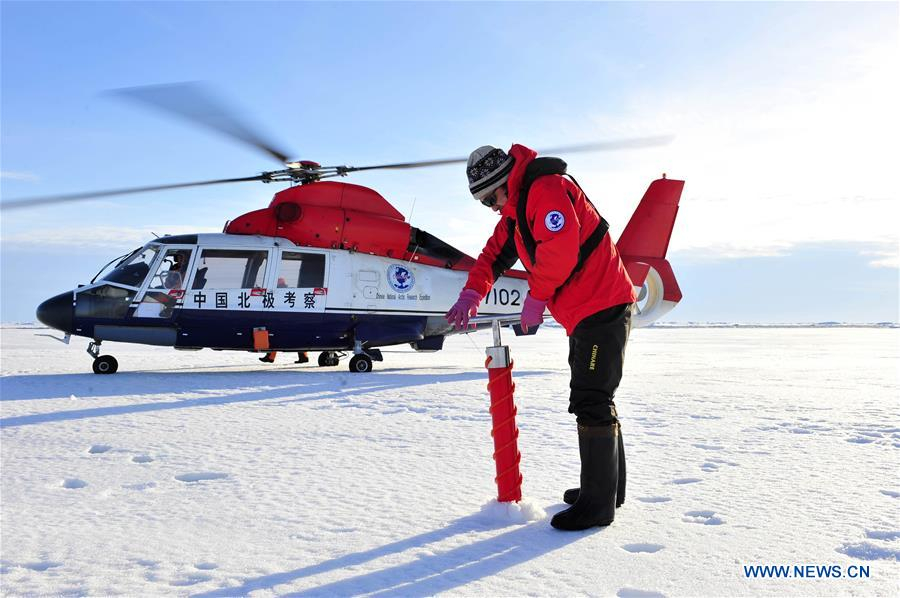
He Jianfeng, a member of the fourth Chinese scientific expedition team, collects an ice core sample at the North Pole, August 20, 2010. /Xinhua Photo
He Jianfeng, a member of the fourth Chinese scientific expedition team, collects an ice core sample at the North Pole, August 20, 2010. /Xinhua Photo
The document underscored that China has shared interests with Arctic states and a shared future with the rest of the world concerning the Arctic.
In July 2017, Russia and China agreed to carry out the Northern Sea Route cooperation and jointly build an "Ice Silk Road," the name at that time.
The Polar Silk Road via the Arctic is widely seen as the third arch of the Belt and Road, adding another sea route in addition to the South China Sea, the Indian Ocean, Africa and the Mediterranean, and the South Pacific and Oceania.
China eyes joint development of oil, gas, mineral resources and other non-fossil energies, fishing, and tourism in the region, with Arctic states, while respecting the traditions and cultures of Arctic residents, including indigenous peoples, and conserving the natural environment.
The white paper promised more on scientific research and environmental protection in the Arctic.
Risks and cooperation
According to a 2018 research by the U.S. National Oceanic and Atmospheric Administration, the Arctic is warming at twice the rate of the rest of the planet.

This file handout photo released by NASA and taken on September 13, 2010, by NASA's Aqua satellite, shows the Arctic sea ice. /VCG Photo
This file handout photo released by NASA and taken on September 13, 2010, by NASA's Aqua satellite, shows the Arctic sea ice. /VCG Photo
It is also widely believed that current trends suggest the polar region will be ice-free during summer as soon as the 2050s.
While this rapid process of ice melting foretells huge commercial opportunities in the Arctic, environmentalists are deeply worried that unprecedented pollutants will also be brought to this once crystal clean territory, due to man-made incidents like oil spills.
Territorial disputes are another hidden danger to some countries, when their extended continental shelf claims run into each other.
But as a tabletop exercise conducted by RAND and RAND Europe with the Norwegian Institute of International Affairs in June 2017 shows, risks for serious tensions in the Arctic during the 2020 decade are likely to be overstated.
The main reason revealed by the exercise is that the exploitation of the rich resources will likely not be economically and technologically viable in the next few decades due to the difficulty of extraction in polar areas.

An attendee inspects a Sherp 4x4 Ultimate Terrain Vehicle (UTV) displayed at the International Arctic Forum in St. Petersburg, Russia, April 9, 2019. /VCG Photo
An attendee inspects a Sherp 4x4 Ultimate Terrain Vehicle (UTV) displayed at the International Arctic Forum in St. Petersburg, Russia, April 9, 2019. /VCG Photo
That said, given the day-to-day leaps and bounds in technological advancement and the fastening of global warming, the day for stakeholders to compete in resource and territory grabbing may arrive sooner than everybody has expected.
When that day comes, to avoid tensions or conflicts, a spirit of cooperation and the ability to see the planet as their common homeland would be direly needed.
That is probably why Russia's Foreign Minister Sergey Lavrov has called for resuming military and political dialogue of Arctic states and suggested holding talks at the level of military experts during the 5th International Arctic Forum on Tuesday.
"The Arctic: An Ocean of Opportunity" is the key theme of the forum this year. Without a doubt, opportunities exit, but how to tread carefully in this ecologically delicate place, so that benefits will not be gained at the expense of environmental deterioration, will be the 64-million-dollar question.
(With input from Xinhua)

